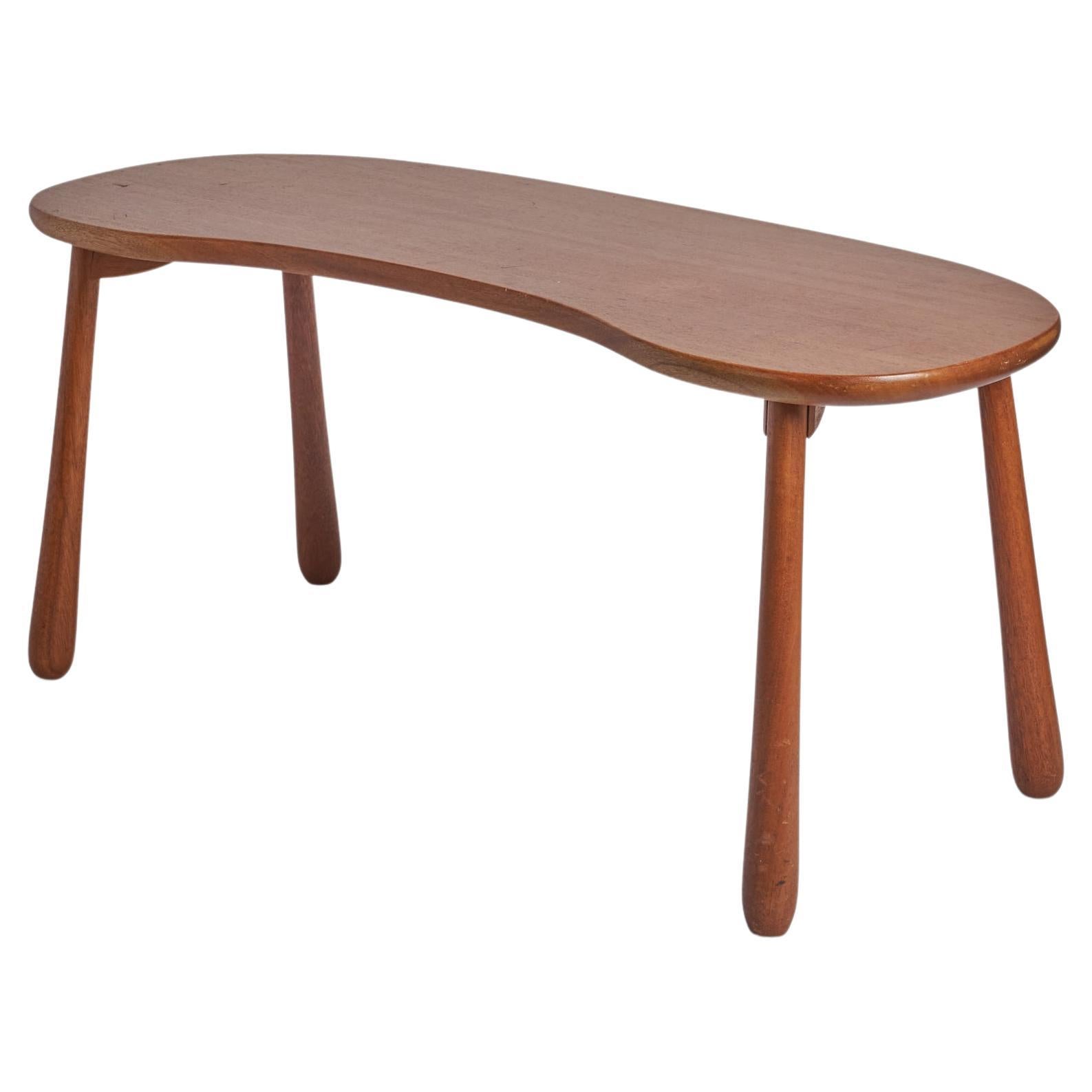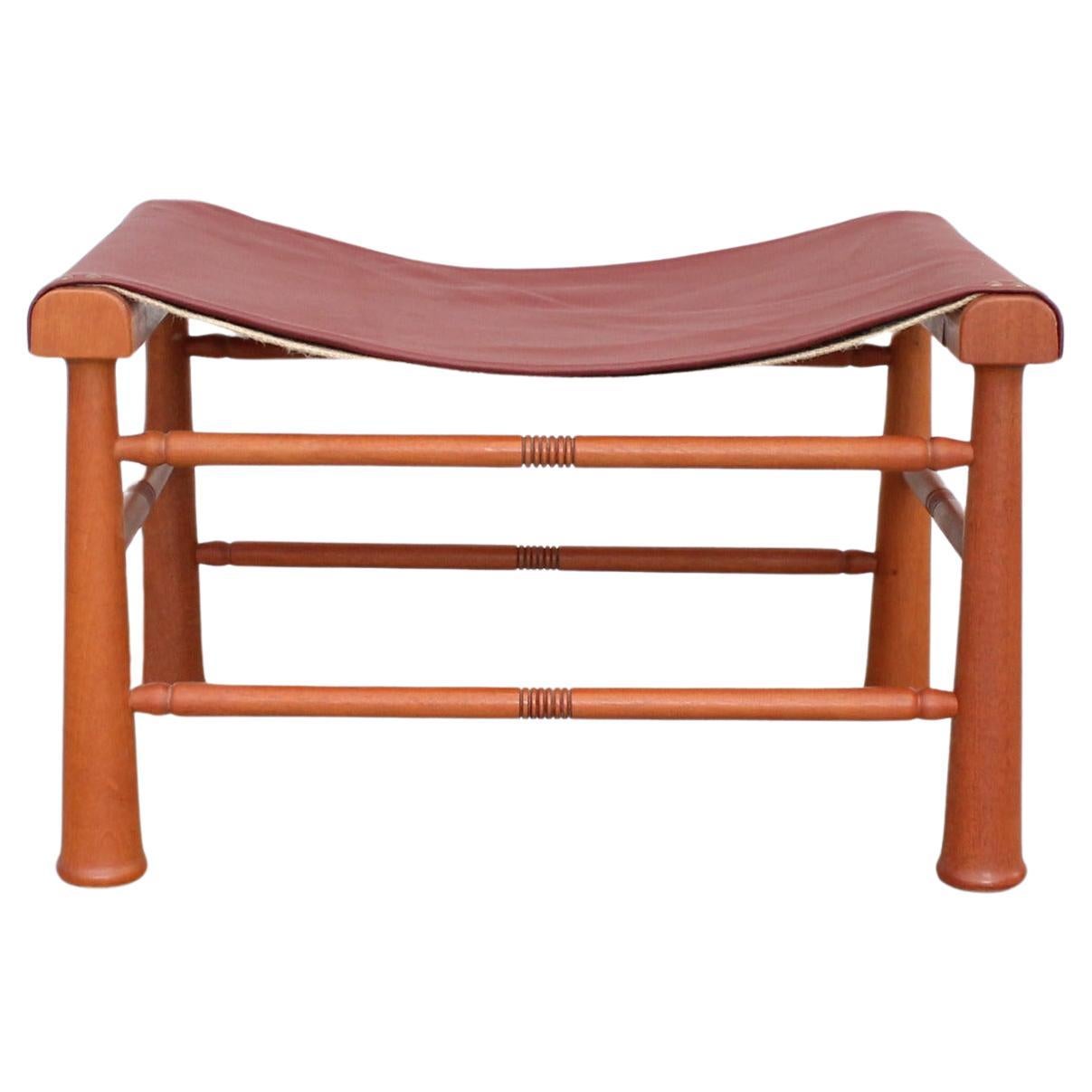Josef Frank, Stool, Svenskt Tenn, 1950s
About the Item
- Creator:Josef Frank (Designer)
- Dimensions:Height: 16.15 in (41 cm)Width: 17.33 in (44 cm)Depth: 11.03 in (28 cm)
- Style:Scandinavian Modern (Of the Period)
- Materials and Techniques:
- Place of Origin:
- Period:
- Date of Manufacture:1950s
- Condition:Wear consistent with age and use.
- Seller Location:Los Gatos, CA
- Reference Number:1stDibs: LU6976231595902
Josef Frank
Austrian architect and furniture and fabric designer Josef Frank was a leading voice for a gentle, humane modernism. His advocacy of warm, comfortable, eclectically styled environments was highly influential in his adopted country of Sweden, and it’s now widely regarded as a harbinger of the backlash against doctrinaire modernism and the embrace of the homespun that occurred in the late 1960s.
The son of a successful Viennese textile manufacturer, Frank studied architecture at Vienna University of Technology, graduating in 1910. From the first years of his practice, he marched counter to the orderly, symmetrical architectural layouts and decors prescribed by contemporaries such as Adolf Loos.
Frank drafted rooms of varying shapes and called for flexible interior-design arrangements. His furniture pieces are light and easy to move — and his chairs are always made of wood, most often with lushly curved steam-bent arms and slatted backs. Frank openly loathed the tubular steel furnishings and “machine for living” aesthetic promoted by Le Corbusier and Ludwig Mies van der Rohe and other Bauhaus principals. “The home must not be a mere efficient machine,” Frank once said. “It must offer comfort, rest and coziness…. There are no puritan principles in good interior decoration.”
Frank — who was Jewish — sensed the dire implications of the rise of Nazism in Germany and Austria, and in 1933 he moved to Stockholm with his Swedish wife, Anna. He became the design chief for the furnishings maker Svenskt Tenn and found a perfect match culturally for his brand of simple, relaxed and bright creations. Like many modernists — notably Charles and Ray Eames and Alexander Girard — Frank had a deep love of folk art, which influenced his designs for a wide array of colorful, richly patterned upholstery fabrics, many based on the classic “Tree of Life” motif.
In all his designs, Frank took inspiration from a broad variety of sources. In his furniture, one can discern traces of Asian patterns, Rococo, Italian Renaissance, Scandinavian handicrafts and even Chippendale pieces. As such, the work of Frank — the friendly modernist — is at home in any type of décor.
Find vintage Josef Frank pillows, armchairs, floor lamps and other furniture on 1stDibs.
- ShippingRetrieving quote...Ships From: Stockholm , Sweden
- Return PolicyThis item cannot be returned.
- Josef Frank, Library Table, Svenkt Tenn, 1950sBy Josef FrankLocated in Los Gatos, CAJosef Frank (1885-1967). Library table. Model number 2117. Firma Svenskt Tenn 1950s. Tops in valnöt, Legs in oak. Measures: L 180, B 55, H 75 cm. Designed in 1951.Category
Vintage 1950s Swedish Scandinavian Modern Console Tables
MaterialsOak, Walnut
- Side Table Model 961 Designed by Josef Frank for Svenskt Tenn, SwedenBy Josef FrankLocated in Los Gatos, CASide table/Occasional model 961 designed by Josef Frank for Svenskt Tenn, Sweden, 1950s. Mahogany.Category
Vintage 1950s Swedish Scandinavian Modern Side Tables
MaterialsMahogany
- Josef Frank library table, Sweden, 1950sBy Josef FrankLocated in Los Gatos, CAImportant and discontinued piece by Josef Frank for Svenskt Tenn. Designed in 1951. Top in Walnut and legs in oak. 180cm long, 55 width, 75 heightCategory
Vintage 1950s Swedish Scandinavian Modern Console Tables
MaterialsOak, Walnut
- Josef Frank, Floor Lamp, 1950s, SwedenBy Josef Frank, Svenskt TennLocated in Los Gatos, CAJosef Frank, floor lamp, model 2564, Firma Svenskt Tenn. Mahogany feet. Brass with a white lacquered stem. Textile-covered screen. Height 150 cm.Category
Vintage 1950s Swedish Scandinavian Modern Floor Lamps
MaterialsBrass
- Stool, Erik Hoglund, Sweden, 1950sBy Erik HöglundLocated in Los Gatos, CAErik Höglund, pall, ”Grisen”, (the pig), made by Boda Trä (Boda Wood). 1950s Frame of beech and leather, with seat of green hemp. Branded Boda Trä Measures: Length 60, depth 30...Category
Vintage 1950s Swedish Scandinavian Modern Stools
MaterialsBeech
- Josef Frank, Coffee Table 2139, Designed 1952By Josef FrankLocated in Los Gatos, CAVery beautiful Josef Frank coffee table with a rare burl wood top in excellent condition. Very vibrant wood color and no fading. Originally designed in 1952, this model is from the 1980s and manufactured by Eriksson & Söners Möbelsnickeri Vrena, Sweden. Josef Frank (1885-1967) was an Austrian architect. He studied architecture at the Kunstgewerbeschule. He started out by designing public housing and social architecture. Although at the beginning of his career he was one of the frontrunners of the Vienna...Category
Vintage 1980s Swedish Scandinavian Modern Coffee and Cocktail Tables
MaterialsWalnut, Burl
- Midcentury stool by Josef Frank, Svenskt Tenn, Sweden, 1950sBy Josef Frank, Svenskt TennLocated in Stockholm, SENeat stool by Josef Frank, made from mahogany with elegantly sculpted feet. Rattan seat in a densely wreathed pattern.Category
Vintage 1950s Swedish Scandinavian Modern Stools
MaterialsRattan, Wood
- Stool Model 927 Designed by Josef Frank for Svenskt Tenn, Sweden, 1950sBy Josef FrankLocated in Stockholm, SEStool model 927 designed by Josef Frank for Svenskt Tenn, Sweden, 1950s. Mahogany and rattan. Measures: H: 43 cm W: 43 cm D: 28 cm Josef Frank was a true European, he was also a pioneer of what would become classic 20th century Swedish design and the “Scandinavian Design Style”. Austrian- born Frank started his design career as an architect after having trained at the Technische Hochschule in Vienna between 1903 and 1910. After his training he went on to teach at Kunstgewerbeschule (The Viennese School of Arts and crafts) where he developed and espoused the new school of modernist thinking towards Architecture and Design that was coming to fruition in Vienna at the time. He also went on to lead the Vienna Werkbund throughout the 1920s. This was a truly progressive group of Architects and Designers who set about improving the daily lives of Austrian people through modernist design and architecture in partnership with Arts and Crafts ideals and construction. Frank’s leadership of the Werkbund had already cemented his place at the forefront of European design. Frank’s time in Vienna was typified by his design for the “Die Wohnung” exhibition of the Deutscher Werkbund in Stuttgart, 1927 where he exhibited along side his contemporaries at the forefront of design, such as the likes of Le Corbusier and Walter Gropius. Here he showed a specially designed pair of flat-roofed reinforced concrete houses in what is now seen as a typical modernist style. What separated Frank’s house from the other 32 houses of the exhibition was the interior and furniture inside the building. It was described as “Neo-Classical” and filled with an eclectic mix of period pieces, modern design and pieces designed by Frank himself that seemed to cross the two worlds. This was a complete opposite direction to that which his fellow Architects were travelling in with their pared back and angular aesthetics. Frank said of his own work: “The house is not a work of art, simply a place where one lives,” and by this reasoning Frank rejected the regimental mechanisation of the living space that his contemporaries believed in, instead he set about creating congenial and spontaneous interiors. Frank’s practice saw him placing the bright colours and the soft forms of nature back into the furnishings and interiors that he thought modernism sorely mist. Frank, along with Oskar Walch set up Haus und Garten in Vienna in 1925. This was Frank’s first commercial foray into furniture and home furnishings and the company went on to become the most influential furnishing house in Vienna with a riotous depth of colour and interesting shapes becoming the trademark of their design. However this success was to come to an end with rise of Nazism in Vienna in the early 1930’s. Frank was Jewish, and he and his wife Anna decided they would leave Vienna for her motherland: Sweden, in 1933. Frank continued to design for Haus and Garten, visiting Vienna occasionally and designing the pieces that would continue to be the company’s best sellers long after Frank was forced to hand the company over in 1938 after the Third Reich annexation of Austria. When Josef and Anna had moved to Sweden Frank had struck up a working relationship with Design shop owner Estrid Ericson. Ericson was the proprietor of Svenskt Tenn that at this point was a successful interiors shop in Stockholm with the royal warrant of appointment to the Swedish Royal Household. In 1935 Frank had become the chief designer for Svenskt Tenn and had set about putting all of his creative effort into his designs for the company. At the World Expositions in Paris in 1937 and New York in 1939 the world saw for the first time the wealth of products that Frank had been working on, ranging from candlesticks to cabinets, there was not a domestic object that Frank had not subjected to his colourful, comfortable and organic style of Modernism. Frank’s new school of Modernism championed ideas such as chairs having a freeing, open back and that “If one desires the room to be comfortable…all pieces of furniture should allow for a free view of the separating line between the floor and the wall. A cabinet without legs breaks this line and thus reduces the feeling of space.” A world-wide audience tired of classic Modernism’s furniture with solid planes and aggressive forms leapt upon these ideas and Franks natural and bright designs for Svenskt Tenn became internationally desired. Frank created over 2000 designs for Svenskt Tenn and his products continue to be the core of their brand. Frank’s rejections of tubular metal and heavy lacquers within his furniture have insured his unique light form of Modernism continues to influence and flourish today. His natural toned mahogany and walnut pieces along with his tactile leather covered and brightly shaded lighting still bring the forms of nature back into the home. Original Frank pieces are now increasingly rare, highly desirable and are the epitome of “Scandinavian Design”. Renowned Designer and Academic Isle Crawford...Category
Vintage 1950s Swedish Mid-Century Modern Chairs
MaterialsRattan, Mahogany
- Josef Frank, Stool or Bench, Mahogany, Svenskt Tenn, Sweden, 1970sBy Josef Frank, Svenskt TennLocated in High Point, NCA mahogany stool or bench designed by Josef Frank and produced by Svenskt Tenn, Sweden, 1970s.Category
Vintage 1970s Swedish Scandinavian Modern Stools
MaterialsMahogany
- Josef Frank stool model 972 by Firma Svenskt Tenn, SwedenBy Josef Frank, Svenskt TennLocated in Forserum, SEStool model 972, a 1940 design by Josef Frank for Firma Svenskt Tenn. Crafted from solid mahogany, it features rich red leather upholstery and decorative brass rivets along the sides...Category
Vintage 1940s Swedish Scandinavian Modern Stools
MaterialsLeather, Mahogany
- Josef Frank stool model 972 by Firma Svenskt Tenn, SwedenBy Josef Frank, Svenskt TennLocated in Forserum, SEStool model 972, a 1940 design by Josef Frank for Firma Svenskt Tenn. Crafted from solid mahogany, it features rich red leather upholstery and decorative brass rivets along the sides...Category
Vintage 1940s Swedish Scandinavian Modern Stools
MaterialsLeather, Mahogany
- Josef Frank stool model 1034 by Firma Svenskt Tenn, SwedenBy Josef Frank, Svenskt TennLocated in Forserum, SEStool model 1034, designed by Josef Frank for Firma Svenskt Tenn. Its versatile design makes it suitable for use as both a stool and a low organic side table. Crafted from solid maho...Category
Vintage 1940s Swedish Scandinavian Modern Stools
MaterialsMahogany






